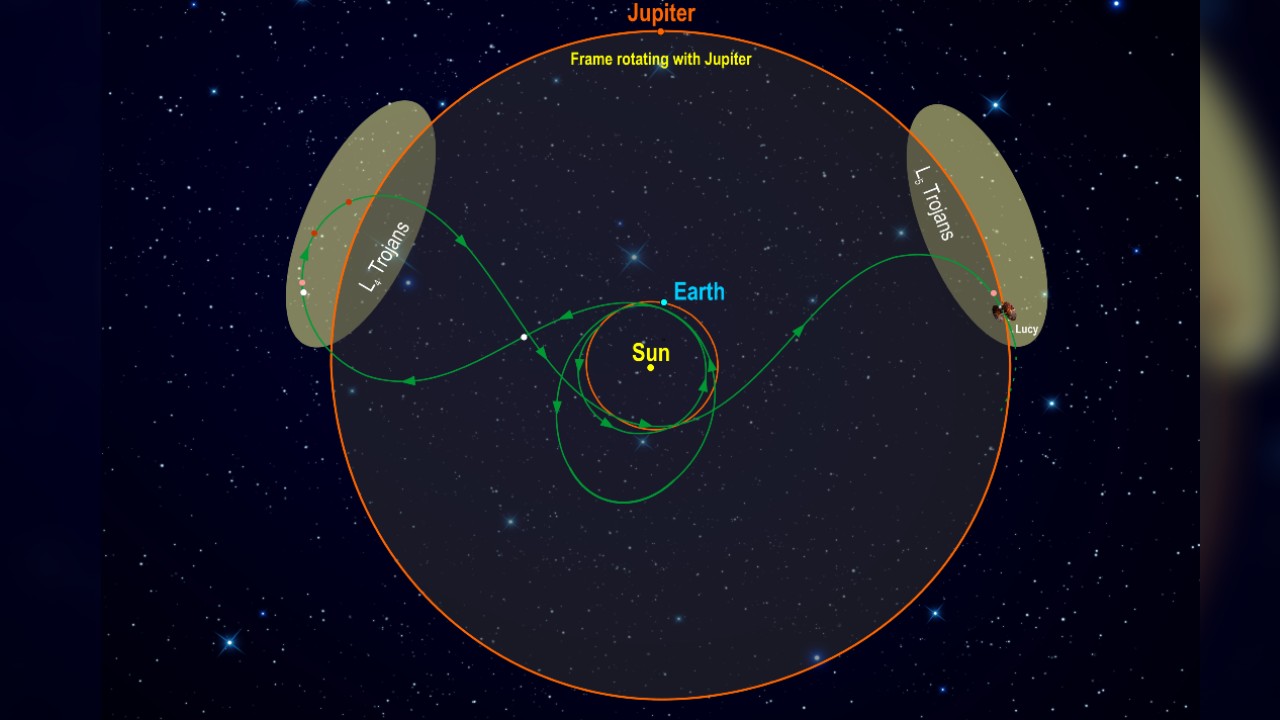Lucy mission: NASA's asteroid explorer
NASA’s Lucy mission is a spacecraft to explore ancient asteroids that orbit at the limits of our solar system.

The NASA Lucy mission is an incredible space expedition that will explore the history of the solar system and reveal more about life on Earth.
The NASA Lucy launch took place on Oct. 16, 2021, and the spacecraft will fly 445 million miles away from Earth to explore swarms of asteroids that orbit the sun in two groups — one ahead of Jupiter, and one behind, according to NASA. They're called the Trojan asteroids, and no spacecraft ever paid them a visit.
These asteroid clusters have been orbiting the Sun for billions of years, and NASA's pre-mission tests show that they're probably made from the same ancient material that originally formed planets like Jupiter, Neptune and Saturn. In lunar terms, they're simple, but they’re time capsules that could give humanity some incredible insights into the birth of the solar system and the formation of life.
Related: What's the difference between asteroids, comets and meteors?
What's the NASA Lucy mission plan?
The NASA Lucy mission's sheer distance means it’s a long-term journey — the probe will fly past Earth on Oct. 15, 2022 and use our planet's gravitational pull in several different phases so it can be flung towards the Trojan clusters, according to NASA.
Lucy will arrive at the main solar system’s asteroid belt in April 2025, and it’ll analyze seven different Trojan asteroids between 2027 and 2033. And then, in March 2033, the Lucy mission will end. But Lucy won’t stop there – it will continue its solar orbit for millions of years.
NASA first mooted Lucy in 2015, and it was formally picked as a viable mission in 2017. Its first designs were approved in 2018, and it began assembly and testing in August 2020. The final NASA Lucy spacecraft arrived at Kennedy Space Center in Florida in July 2021 ahead of the autumn launch period, according to NASA’s Lucy mission webpage.

Lucy might seem an odd name for a space mission, but it's named after a fossilized skeleton called Lucy that was discovered in Ethiopia in 1974. That fossil is around 3 million years old, and it taught us loads of new things about the evolution of humanity, according to Arizona State University. So it's a fitting name for a space mission that NASA hopes will lead to similar discoveries from interstellar fossils.
Related: The James Webb Space Telescope: Origins, design and mission objectives
What will the NASA Lucy spacecraft test?
The NASA Lucy spacecraft will fly past seven Trojan asteroids and carry out remote testing with its range of advanced instruments. NASA plans to examine the geology on the surface of each asteroid to check out their age, structure and shape, and other tools will check each asteroid for minerals, ice and organic materials, according to NASA’s Lucy mission webpage.
Other tools will measure the mass and density of each asteroid and will map their interior structures, too.
NASA doesn’t quite know what Lucy will find — after all, no mission has ever been there. But the mission will supply vital information about the formation of our solar system, and this sort of exploration is a vital part of scientific discovery.

Gravitational pull: Exploring Lucy’s orbits
The NASA Lucy spacecraft uses solar energy for power in deep space, but it will orbit Earth, Mars and the sun and rely on their gravitational pull to start its journey to the outer reaches of space, according to NASA’s Lucy mission webpage.
Lucy’s first task is to orbit the sun, and by October 2022 it'll hurtle back toward Earth and get a gravity-assisted boost that will speed up the spacecraft. This speed will take Lucy on a two-year orbit around Mars before it comes back to Earth in 2024 for another shot of gravitational help.
It’s this second shove that will propel Lucy toward the solar system’s main asteroid belt — and, beyond that, to the first cluster of Trojan asteroids. Once it has looped around those, Lucy will head back to Earth for its third gravitational boost, and this will push the spacecraft in the opposite direction, toward the second group of Trojan satellites.
Targets of the Lucy mission
Target 1: (52246) Donaldjohanson
Lucy's smallest target is in the solar system's main asteroid belt, not the Trojan clusters. The target is 130 million years old, and NASA will use this asteroid to test Lucy's instruments. Estimated fly-by date: April 20, 2025
Target 2: (3548) Eurybates
NASA suspects that this asteroid shares the same materials as some meteorites on Earth, and Eurybates has its own satellite — so Lucy can study two asteroids in the same visit. Estimated fly-by date: Aug. 12, 2027
Target 3: (15094) Polymele
This is Lucy's smallest target, at 13 miles (21 kilometers) across, and NASA believes that it's rich in organic material, and worth studying for insights into how life formed in the solar system. Estimated fly-by date: Sept. 15, 2027
Target 4: (11351) Leucus
This slow-rotating asteroid has a day that lasts for 446 hours, and that slow day means it has huge temperature variations — so NASA can learn loads about the materials inside. Estimated fly-by date: April 18, 2028
Target 5: (21900) Orus
This asteroid is similar to Leucus, so NASA hopes that tests on Orus will reveal more about the similar organic and carbon-based materials found here. Estimated fly-by date: Nov. 11, 2028
Target 6: (617) Patroclus and Menoetius
These large, paired asteroids are thought to be left over from the early days of the solar system, and NASA reckons they will provide information about how planets were formed. Estimated fly-by date: March 3, 2033
Additional resources
- NASA: Solar System Exploration
- Our Solar System: An Exploration of Planets, Moons, Asteroids, and Other Mysteries of Space by Lisa Reichley
- Asteroids (Kosmos) by Clifford J. Cunningham
Sign up for the Live Science daily newsletter now
Get the world’s most fascinating discoveries delivered straight to your inbox.
Mike is a freelance technology journalist and consultant who is fascinated with gaming, futuristic technology and motorsport. Previously, Mike has worked as a writer for PC Pro magazine writing and published articles on technology for many other media outlets, including TechRadar, Wired, PC Advisor, Stuff, The Inquirer and Red Bull Gaming.











